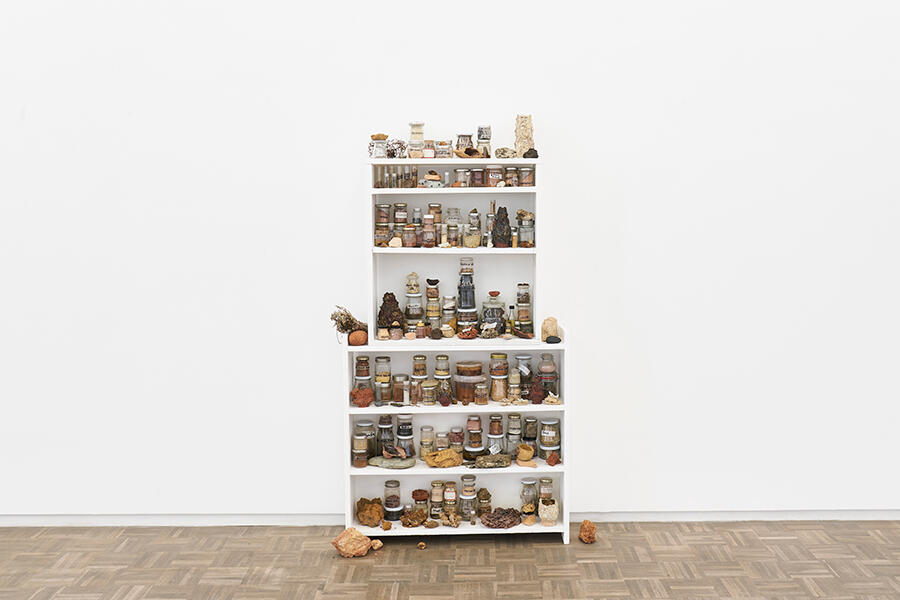‘The weight of a stone’ Digs up Dirt
A group exhibition at blank projects, Cape Town, brings together artists whose work experiments with the materiality of the earth
A group exhibition at blank projects, Cape Town, brings together artists whose work experiments with the materiality of the earth

Anchored by two concrete blocks on the floor, a white rope cuts a lithe diagonal across Cape Town’s blank projects, simultaneously bisecting the room and tying one corner of it to another. It takes my eye a moment to trace its line to the small bag of sea salt suspended from it. Titled A Pound of Flesh (2022), this meditation on heaviness and balance by Inga Somdyala is an appropriate introduction to ‘The weight of a stone’, a group exhibition that brings together an ensemble of mostly South African artists whose work experiments with the materiality of the earth.

Curated by Lemeeze Davids and Thobile Ndenze, the show is split into four loose sections: clay, metal, soil and stone. The resulting dialogue between these minerals reveals how they each weigh on one another and, more importantly, the weight of their relationship with humans. But, rather than being one more bleak exhibition about the Anthropocene, ‘The weight of a stone’ doesn’t simply paint a painful picture of our devastation of the Earth. Instead, through their inventive engagements with natural substances, the exhibited artists make the case for these materials as co-conspirators and creative forces in their own right.

Jean-Marie Malan’s After Science Fiction (2022), for example, was crafted through a kind of collaborative ballet between the material and the artist – who trained as a dancer – wherein Malan shaped the forms of the sculpture with the curves of her arms. Transformed through partnership with the artist, the aluminium appears almost fluid, its shiftless curves lending it a vitality that seemingly betrays its solid state.

In the sections on clay and stone, the featured artists delight in playful assembly. Zayaan Khan’s installation AncientFutures Artefacts (2015–22) is a bricolage of clay objects from around her studio, including ceramic bowls, plants and snakes. On the other side of the gallery, sculptor Belinda Blignaut responds in kind with a shelf from her studio. Titled We Are Earth (2016–ongoing), the installation overflows – literally spilling onto the floor – with materials that the artist uses in her everyday practice: rocks, jars of soil and leaves from across the world. Given their own ‘voice’ as creative agents, these materials are presented independently of the sculptures and mixed-media works that they are expected to yield.

Nolan Oswald Dennis stages a scene similarly based in collecting and sampling but with a focus on soil. His sculpture //hui!gaeb cluster (shrine, strand, yardie, promise, acts & graves) (2022) is named after six different sites in Cape Town, or hui!gaeb in the indigenous South African language Khoi. For this cooperative work, the artist instructed blank projects to collect soil from each location, which he subsequently shaped into a row of six uniquely hued columns – each charged with its own history of place. Nearby, Somdyala’s second installation, Isala Kutyelwa … (It Remains to be Paid, 2022), takes its name from an isiXhosa proverb and comprises an ochre-coated canvas draped elegantly over a short rope. Its earthy folds evoke a traditional Xhosa garment made from ochre-hued blankets, evoking the cultural tethers that bind us to the Earth.

Using materials that are richly alive and fulsome with creative potential, the works in ‘The weight of a stone’ invite us to view the Earth as a site of possibility rather than abject desecration. While the reality of climate change can easily lead us to reduce the land to a deadened artefact, this exhibition confronts the crisis by demanding that we re-cultivate a respect for the Earth as a vital agent of artistry.
‘The weight of a stone’ is on view at blank projects, Cape Town, until 10 September.
Main image: Noland Oswald Dennis, //hui!gaeb cluster (shrine, strand, yardie, promise, acts & graves), 2022, particular soil, binder, dry pigment, implemented recipe, 39 × 11.5 × 11 cm (each). Courtesy: the artist and blank projects, Cape Town

























